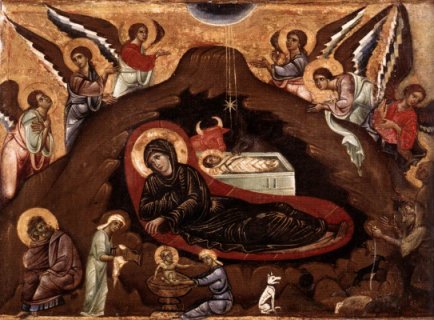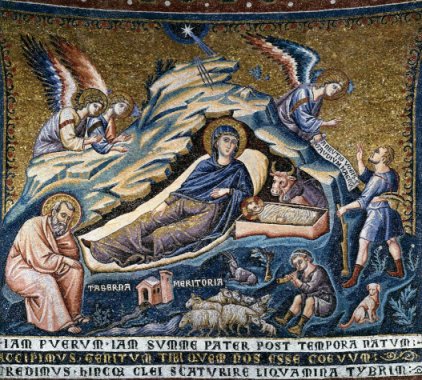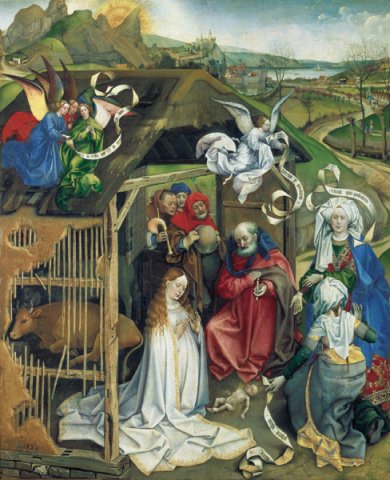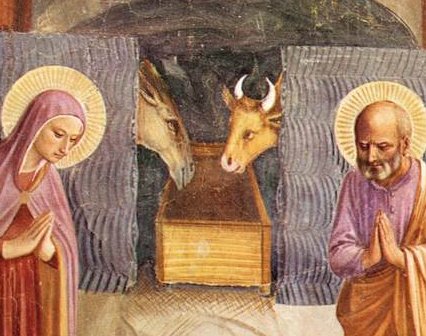|
|
|
|
Location: and the midwives. Early
images of the Birth of Christ reflect apocryphal texts and traditional
storytelling. The most obvious difference between early and late images is
the setting. The tradition, expressed in the Protoevangelium of James, was
that Jesus was born in a cave, a location that has many mythological
parallels. 19. And I saw a woman coming
down from the hill-country, and she said to me: O man, whither are you
going? And I said: I am seeking an Hebrew midwife. And she answered and
said unto me: Are you of Israel? And I said to her: Yes. And she said: And
who is it that is bringing forth in the cave? And I said: A woman
betrothed to me. And she said to me: Is she not your wife? And I said to
her: It is Mary that was reared in the temple of the Lord, and I obtained
her by lot as my wife. And yet she is not my wife, but has conceived of
the Holy Spirit. And the midwife said to him: Is
this true? And Joseph said to her: Come and see. And the midwife went away
with him. And they stood in the place of the cave, and behold a luminous
cloud overshadowed the cave. And the midwife said: My soul has been
magnified this day, because my eyes have seen strange things— because
salvation has been brought forth to Israel. And immediately the cloud
disappeared out of the cave, and a great light shone in the cave, so that
the eyes could not bear it. And in a little that light gradually
decreased, until the infant appeared, and went and took the breast from
His mother Mary. And the midwife cried out, and said: This is a great day
to me, because I have seen this strange sight. And the midwife went forth
out of the cave, and Salome met her. And she said to her: Salome, Salome,
I have a strange sight to relate to you: a virgin has brought forth— a
thing which her nature admits not of. Then said Salome: As the Lord my God
lives, unless I thrust in my finger, and search the parts, I will not
believe that a virgin has brought forth. 20. And the midwife went in,
and said to Mary: Show yourself; for no small controversy has arisen about
you. And Salome put in her finger, and cried out, and said: Woe is me for
mine iniquity and mine unbelief, because I have tempted the living God;
and, behold, my hand is dropping off as if burned with fire. And she bent
her knees before the Lord, saying: O God of my fathers, remember that I am
the seed of Abraham, and Isaac, and Jacob; do not make a show of me to the
sons of Israel, but restore me to the poor; for You know, O Lord, that in
Your name I have performed my services, and that I have received my reward
at Your hand. And, behold, an angel of the Lord stood by her, saying to
her: Salome, Salome, the Lord has heard you. Put your hand to the infant,
and carry it, and you will have safety and joy. And Salome went and
carried it, saying: I will worship Him, because a great King has been born
to Israel. And, behold, Salome was immediately cured, and she went forth
out of the cave justified. And behold a voice saying: Salome, Salome, tell
not the strange things you have seen, until the child has come into
Jerusalem. |
|
|
|
|
|
|
|
|
The Ox and the Ass It is often assumed that the reference to a manger in Luke's gospel was the inspiration for the ox and the ass. Not so; the idea comes from the Pseudo-gospel of Matthew: And on the third day after the birth of our Lord Jesus Christ, the most blessed Mary went forth out of the cave, and entering a stable, placed the child in the stall, and the ox and the ass adored Him. Then was fulfilled that which was said by Isaiah the prophet, saying: The ox knoweth his owner, and the ass his master's crib. The full quote from Isaiah (Chapter 1 v 3) is The ox knoweth his owner, and the ass his master's crib: but Israel doth not know, my people doth not consider. Geza Vermes in The Nativity suggests that this reference was regarded by the church as a prefiguration of the rejection of Christ by the Jewish people. He also reminds us of the tradition that the ox represented the Jews, and the ass the gentiles. The Golden Legend tells us that Joseph and Mary brought the ox and the ass with them from Nazareth. The ass makes sense as a means of transport, by why an ox? Rather lamely, The Golden Legend suggests Joseph might have intended to sell it. The sleeping Joseph Joseph is often shown asleep. It might be thought that he is simply tired out after the long journey from Nazareth. More likely, I think, is that Joseph is having his dream - the warning of the massacre of the innocents and the need to flee to Egypt. |
|
|
|
|
|
The legend of Joseph's socks. I promise I'm not making this one up! A legend with very obscure origins! Mary and Joseph, being poor, could not afford swaddling clothes. So Joseph cut up his socks (or hose, if you prefer) for this purpose. These items are now a much revered relic in the cathedral at Aachen. This painting by an unknown German master illustrates the legend. |
|
|
|
|
|
Finally, to return to the
Protoevangelium, and to Chapter 18, in which Joseph speaks in the first
person of the actual moment of birth. It is a most extraordinary text, and has never, to my knowledge,
been illustrated. But then, motionlessness is not the easiest idea
to illustrate in art. |
|






